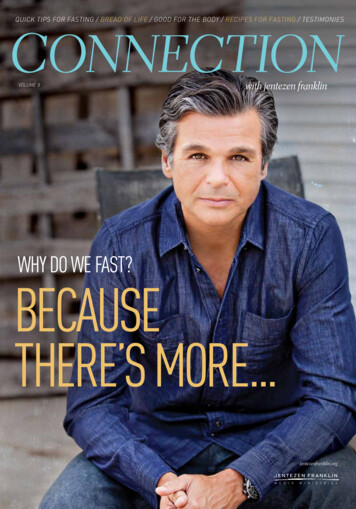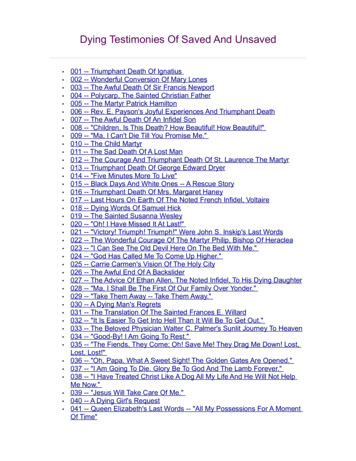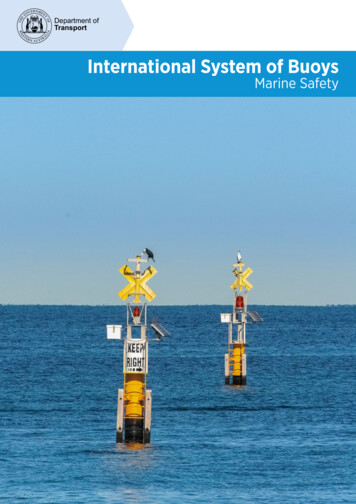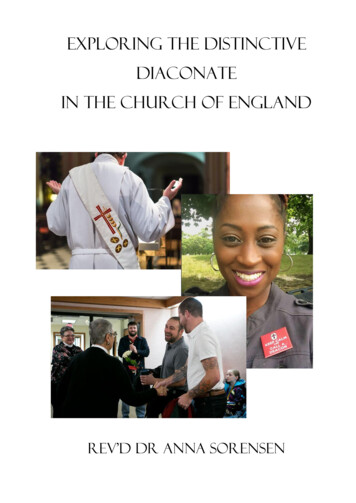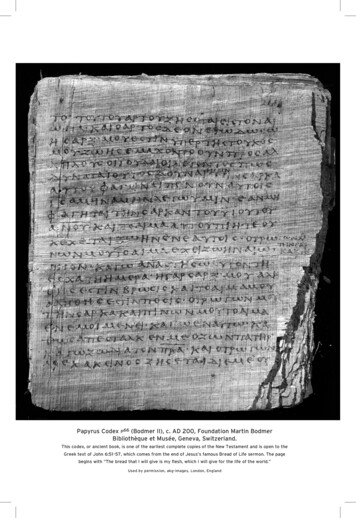
Transcription
Papyrus Codex p66 (Bodmer II), c. AD 200, Foundation Martin BodmerBibliothèque et Musée, Geneva, Switzerland.This codex, or ancient book, is one of the earliest complete copies of the New Testament and is open to theGreek text of John 6:51–57, which comes from the end of Jesus’s famous Bread of Life sermon. The pagebegins with “The bread that I will give is my flesh, which I will give for the life of the world.”Used by permission, akg-images, London, England
The Distinctive Testimoniesof the Four GospelsGaye Strathearn and Frank F. Judd Jr.Gaye Strathearn (gaye strathearn@byu.edu) and Frank F. Judd Jr.(frank judd@byu.edu) are assistant professors of ancient scripture at BYU.Church curriculum for Matthew, Mark, Luke, and John generally follows a harmony approach. This method reconstructs the life ofJesus Christ by merging all the Gospel accounts and hypothesizing achronology.1 This approach has ancient roots: Tatian, an early Christian apologist, used the four Gospels to create one single harmony, theDiatessaron (c. AD 175).2 This text was very influential in Syria duringthe third and fourth centuries.A harmony approach has some advantages, including providinga comprehensive view of what the Gospels record of the Savior’s lifeand teachings. This approach, however, also has some limitations. Forexample, no harmony of the Gospels can provide a complete account ofChrist’s life because the Gospels were essentially individual testimonieswritten for different audiences and were not intended to be all-inclusiveaccounts of Christ’s life and teachings. Significantly, the Joseph SmithTranslation designates the Gospel of Matthew and the Gospel of Johnas “testimonies” rather than “gospels.”3 Elder McConkie stated, “It isapparent . . . that each inspired author had especial and intimate knowledge of certain circumstances not so well known to others, and thateach felt impressed to emphasize different matters because of the particular people to whom he was addressing his personal testimony.”4Another limitation of the harmony approach is illustrated byPapias, a second-century church leader who quoted John the presbyter’s statement that Mark “wrote down accurately, but not in order, allthat [Peter] remembered of the things said and done by the Lord.”5
60The Religious Educator Vol 8 No 2 2007As a further complication, the Gospels of Matthew and Luke sometimes record a different order of events than does the Gospel of Mark.Because the Gospels occasionally differ in their order of events, scholarshave a difficult time establishing a precise chronology for a harmony.6A third limitation is that a harmony approach obliterates the uniqueemphases of the individual Gospel writers. While there is much that theGospel authors agree upon, each has written to a different audience,with a different purpose in mind. John’s Gospel, in particular, containsan abundance of material not found in the other Gospel accounts. Yeteven the synoptic Gospels—Matthew, Mark, and Luke, which relatemany of the same events and teachings—present their shared materialin ways that are unique to their Gospels. In other words, each Evangelist wrote his account for a specific purpose and expected that hisportrait of the Savior would be seen as complete in itself.7Modern readers can learn much from the Gospels by examiningwhat they chose to include and how they chose to write it. In this article, we will examine some of the ways that each author has presentedthe life and teachings of the Savior. Such a study will allow teachers andreaders to appreciate better the distinctive contributions of each Gospelto our understanding of the life and teachings of our Savior.8This article will discuss dating, authorship, and provenance of eachGospel and then summarize the distinctive witness of Jesus Christthat each account provides. The scope of this article does not allowa complete, detailed examination; instead, we will focus on some ofthe general themes. The notes contain additional sources that will aidreaders who wish to investigate further. This study will begin withMark’s Gospel because it is likely the earliest of the synoptics.9 We willthen continue with Matthew and Luke, who are likely dependent uponMark’s account, noting some ways that they have edited the Gospel ofMark and included their own unique material. Finally, we will concludewith the most unique Gospel, written by John.The Gospel of MarkOf the four Gospel writers, Mark is the only one to call his worka “gospel”: “The beginning of the gospel of Jesus Christ, the Son ofGod” (Mark 1:1). The identification of the first four books of the NewTestament as Gospels, therefore, originates from Mark’s introduction.The word Gospel comes from the Greek word euangellion, which means“good news.”10 The good news of Jesus Christ is that He came to earthto perform His mission for us (see 3 Nephi 27:13–21).
The Distinctive Testimonies of the Four Gospels61Dating, authorship, and provenance. Most scholars date the Gospelof Mark to the time of the Jewish War (c. AD 66–73). This dating isdue, in part, to the Savior’s reference to the destruction of Herod’sTemple (see Mark 13:2) that occurred in AD 70. For scholars who donot accept the possibility of prophecy, Mark’s Gospel could not havebeen written before that event. But as Joel Marcus has concluded, “Infavor of a pre-70 dating is the probability that Jesus actually prophesiedthe Temple’s destruction, as did other Jewish prophets down throughthe centuries; . . . a prophecy of its end, therefore, would not require apost-70 date.”11 Some early Christian traditions claim that Mark wrotehis Gospel around the time of the death of Peter, which occurred inRome in AD 64 or 65.12Mark is often identified with “John, whose surname was Mark,” themissionary companion of Paul during the Apostle’s first mission (Acts12:25). According to the book of Acts, John Mark left that missionearly to return to Jerusalem (see Acts 13:13). The cause for John Mark’searly departure is unknown, but it later caused a temporary rift betweenBarnabas and Paul when, in preparation for their second mission,Barnabas wanted to bring along John Mark but Paul refused (seeActs 15:37–38). Whatever the reason, later tradition claims thatMark continued faithful in the gospel. Papias preserved the followinginformation concerning Mark’s later relationship with Peter: “Markbecame Peter’s interpreter and wrote down accurately, but not inorder, all that [Peter] remembered of the things said and done by theLord. For [Mark] had not heard the Lord or been one of his followers, but later, as I said, a follower of Peter. Peter used to teach as theoccasion demanded, without giving systematic arrangement to theLord’s sayings.”13If this tradition is accurate, Mark did not actually witness the eventshe included in his Gospel but rather wrote down the things he heardPeter teach about the Savior’s ministry. The importance, therefore, ofMark’s Gospel is that it may record the memories of the leader of thefledgling post-resurrection Church.Internal evidence strongly suggests that the Gospel of Mark waswritten for a Gentile, or non-Jewish, audience. For example, Markinterprets Aramaic phrases for his readers, such as “Talitha cumi”(Mark 5:41) and “Eloi, Eloi, lama sabachthani?” (Mark 15:34). Markalso explains Jewish customs and ideas.14 If Mark’s audience were Jewish and spoke Aramaic, there would be no need for such explanations.Significantly, Matthew, who was indeed writing to a Jewish audience,omits Mark’s explanations of these Jewish concepts in his Gospel.15
62The Religious Educator Vol 8 No 2 2007Eusebius, a Christian historian from the fourth century, reported a tradition that Mark wrote his Gospel in Rome.16 Internal evidence from thetext also supports this tradition. First, Mark mentions Roman customs,17which Matthew omits.18 In addition, although Mark’s Gospel was composed in Greek, he often employs Latin terminology.19 He twice interpretsGreek terms with Latin explanations.20 These features seem to indicate thatMark wrote his Gospel to a Gentile, possibly a Roman, audience.Noteworthy themes and perspectives on Christ. Overall, the Gospel ofMark emphasizes that even though Christ’s enemies opposed Him, Hismortal ministry was misunderstood (even by His disciples and relatives)and that although He died a humiliating death upon the cross, the Savior ultimately triumphed over all things. Although a number of themesrecur throughout this Gospel, we will mention just four prominentexamples. A large portion of the Gospel of Mark deals with the themeof Jesus’s authority, as well as opposition to that authority.1. Rather than opening with a birth narrative, the Gospel of Markbegins with the Savior’s baptism by John the Baptist (see Mark 1:9–10). Thus, early in his Gospel, Mark establishes the Savior’s identity byquoting God the Father’s divine approval: “Thou art my beloved Son,in whom I am well pleased” (Mark 1:11). This approval is the foundation from which Mark can demonstrate Jesus’s authority over Satan andhis forces when Jesus casts out an unclean spirit (see Mark 1:23–26),cures the fever of Peter’s mother-in-law (see Mark 1:30–31), and healsthe leper (see Mark 1:40–42). As the Savior asserts His authority, Hemeets intense opposition from Satan and his forces (Mark 1:12–13),the scribes and Pharisees (Mark 2:16–17), and eventually the chiefpriests (Mark 14:1). Examples of this theme of opposition are repeatedthroughout Mark’s Gospel.212. The Gospel of Mark shows that misunderstanding affected Jesuson a deeply personal level. Although the Savior demonstrates His authority to the house of Israel, they do not completely understand His identity(see Mark 1:27; 4:11–12; 8:27–28). Notwithstanding the Savior’s commission to the Apostles to teach His message and use His authority (seeMark 3:14–15), His own disciples do not entirely comprehend His trueidentity, nor do they fully grasp the scope of His earthly mission (seeMark 4:36–41). When Jesus returns to His hometown of Nazareth,instead of receiving Him with open arms, the townspeople reject Him(see Mark 6:1–4). Perhaps most disturbing of all is that apparently members of Jesus’s own family rejected Him (see Mark 3:21).22 The Savior, ofcourse, knew that such rejection would be the reaction to His messageand mission. Just as John was “handed over” (paradid mi) because of
The Distinctive Testimonies of the Four Gospels63his preaching, so would the Savior suffer the same fate (Mark 1:14; seealso 14:41, where “betrayed” is also paradid mi). The parable of thesower also emphasizes the idea that most people would indeed reject theSavior (see Mark 4:3–8).233. The Gospel of Mark emphasizes the idea of secrecy surrounding the Messiah’s mission. From the inception of His ministry, Jesuscommands those that He encounters to keep quiet about Him. Forexample, when the Savior cast out an evil spirit, He declared, “Holdthy peace, and come out of him” (Mark 1:25).24 After Jesus healsthe leper, He commands, “See thou say nothing to any man” (Mark1:44). Mark hints that Jesus is intentionally keeping people in the darkabout certain aspects of His mission (see Mark 4:11–12). Even whenPeter finally declares by inspiration Jesus’s true identity as the Messiah, the Savior “charged them that they should tell no man of him”(Mark 8:30). In addition, after the sacred experience upon the Mountof Transfiguration, the Savior again “charged them that they shouldtell no man what things they had seen” (Mark 9:9). Scholars since theearly twentieth century have called this theme in Mark “the MessianicSecret.”25Why would Jesus command others to keep quiet? One reason islogistical—that is, if too many people crowded around the Savior, Hesimply could not accomplish His work as effectively. When the healedleper was commanded to keep quiet, he disobeyed “and began to publish it much, and to blaze abroad the matter” (Mark 1:45). The resultof this disobedience was that “Jesus could no more openly enter intothe city, but was without in desert places: and they came to him fromevery quarter” (Mark 1:45). A more important reason for the secrecyis apparent, however, because neither the disciples nor Jews in generalunderstood what kind of Messiah Jesus was. Rather than being a powerful military or political figure, Jesus was to be a suffering Messiah. WhenJesus started to teach His disciples about His messianic mission, theirreactions demonstrate why Jesus kept it a secret for so long. After Peter’sfamous confession, Jesus taught, “The Son of man must suffer manythings, and be rejected of the elders, and of the chief priests, and scribes,and be killed, and after three days rise again” (Mark 8:31). Peter’s reaction is unexpected by modern readers: “And Peter took him, and beganto rebuke him” (Mark 8:32). Even when Peter understood by revelationthat Jesus was the Messiah, Peter still did not know what kind of MessiahJesus was. Later, when Jesus told the disciples He would suffer and die(see Mark 9:31), still “they understood not that saying, and were afraid toask him” (Mark 9:32).26 According to Mark, nobody fully understood the
64The Religious Educator Vol 8 No 2 2007mission of the Savior before the suffering of Gethsemane and the cross.4. Mark’s culminating theme is the Savior’s final vindication in spiteof opposition, misunderstanding, and suffering. Each time Jesus taughtHis disciples that He would suffer and die, He included the importantreality that He would also rise from the dead (see Mark 8:31; 9:31;and 10:34). Ironically, following Mark’s narration of the Crucifixion,the Roman centurion gives readers a glimmer of hope by declaring,“Truly this man was the Son of God” (Mark 15:39). The women takethe body of Jesus and wrap it in linen (see Mark 15:46), but when theyreturn to the sepulcher after the Sabbath, they find the stone alreadyrolled away and a man inside dressed in white—but they do not findthe body of Jesus (see Mark 16:4–5). The messenger confirms thatJesus’s prophecy is indeed fulfilled: “He is risen; he is not here” (Mark16:6). The Savior of the world, who was opposed and misunderstoodby all who knew Him and suffered and died a humiliating death, hastriumphed over all things and has risen again!27 He appeared as a resurrected being to Mary Magdalene, two unnamed disciples, and finallyto the Apostles (see Mark 16:9, 12, 14). The triumph of the Savior inthe Gospel of Mark reaches its completion as “he was received up intoheaven, and sat on the right hand of God” (Mark 16:19).In the early days of the New Testament church, Christian missionaries such as the Apostle Paul struggled to deal with the scandalcaused by the Crucifixion: “But we preach Christ crucified, unto theJews a stumblingblock, and unto the Greeks foolishness” (1 Corinthians 1:23). Why didn’t more people readily accept Jesus the crucifiedMessiah? Mark’s Gospel offered an explanation—from the beginning,people completely misunderstood the nature of the Savior’s mission.Mark’s Gospel also offered hope—in spite of continued misunderstanding and opposition to the message of the Savior, Jesus Christ hasrisen from the dead and rules, vindicated, in heaven. In these respects,the Gospel of Mark is as relevant today as ever.The Gospel of MatthewThe Gospel of Matthew was very influential among early Christians.28 Tertullian, one of the early church fathers (c. AD 155–230),describes Matthew as the “most faithful chronicler of the Gospel.”29 Inthis dispensation, the Prophet Joseph Smith often used the first Gospelin his sermons.30Dating, authorship, and provenance. Because of Matthew’s dependence on Mark’s Gospel, the Gospel of Matthew is normally dated afterabout AD 75.31 Most scholars date it to sometime between AD 80 and
The Distinctive Testimonies of the Four Gospels6595.32 In spite of the fact that modern scholars have debated the authorship of this Gospel, ancient Christian writers are unanimous in ascribingit to the tax collector named Matthew identified in Matthew 9:9.33Although we may never be able to identify a specific community ina specific city as Matthew’s intended audience, clues from both externaland internal evidence help us draw some broad conclusions. Althoughwe do not know his source, Eusebius says, “Matthew at first preachedto the Hebrews, and when he planned to go to others also he wrotehis Gospel in his own native tongue for those he was leaving.”34 Internal evidence from the Gospel itself seems to confirm that the intendedaudience was Jewish.35 Unlike Mark, Matthew does not explain Jewishconcepts for his audience, such as the washing of hands (15:2) and theuse of phylacteries (23:5); he uses Aramaic terms such as raka (5:22)and korbanas (27:6, translated as “treasury”), without any explanation;and he prefers Jewish phrases such as “kingdom of heaven” (thirty-twotimes) instead of “kingdom of God.” In addition, Matthew begins hiswork with a genealogy that links Jesus with the royal Davidic line andwith Abraham, the father of the covenant (see Matthew 1:1–17).In the text, three characteristics of Matthew’s editorial hand suggest that his audience was in tension with, or had recently split with,the synagogue. Matthew is the only Gospel author to include Jesus’ssayings where he referred to the “church” (ekklēsia; Matthew 16:18;18:17), and in his editorial passages, the synagogue is always referredto as “their” or “your” synagogue (Matthew 4:23; 9:35; 12:9; 13:54;23:34).36 Additionally, Matthew referred to “their scribes” (authors’translation of grammateis aut n; Matthew 7:29), whereas Mark used“the scribes” (hoi grammateis; Mark 1:22). All these Matthean characteristics point to an “us” and “them” situation for Matthew’s audience.Some scholars have argued that this situation reflects a time during theJamnian period (AD 70–100) when Judaism was seeking to define itselfafter the destruction of the temple.37 Rifts within Judaism, however,were not exclusive to this period and may reflect an earlier period.38The tension with the synagogue may account for an importantelement of Matthew’s Gospel: the tension over the role of the Gentileswithin the Christian community. Matthew is the only Gospel authorto mention two of Jesus’s sayings that restrict missionary work amongthe Gentiles. The first is in the apostolic commission in Matthew 10where Jesus specifically directs the Twelve, “Go not into the way ofthe Gentiles and into any city of the Samaritans enter ye not: But gorather to the lost sheep of the house of Israel” (vv. 5–6). The secondis Jesus’s response to the Syro-Phoenician woman who pled with him
66The Religious Educator Vol 8 No 2 2007to heal her daughter in chapter 15. He told His disciples, “I am notsent but unto the lost sheep of the house of Israel” (v. 24). These sayings, however, are offset in the Gospel with a number of places thatemphasize the positive qualities of the Gentiles: Matthew includes fourGentile women in his account of Jesus’s genealogy (Thamar, Rachab,Ruth, and Bathsheba, or “the wife of Urias,” 1:3–6); he portrays theWise Men as Gentiles who recognize and worship the Christ childwhen Herod and the chief priests and scribes do not;39 and he is theonly Gospel writer to emphasize the great faith of two Gentiles—thecenturion (8:10–12) and the Syro-Phoenician woman (15:28). Theseinstances, along with the final commission to go and teach “all nations”(28:19), suggest that Matthew’s Gospel was written to encourage hisJewish audience to accept and embrace the Gentile mission.40 Thisreading of Matthew makes good sense of Eusebius’s statement thatMatthew wrote his Gospel “when he planned to go to others also.”41Noteworthy themes and perspectives on Christ. Matthew wrote hisGospel to testify that Jesus is a tangible manifestation that God has notabandoned His people. Matthew is the only Gospel author to providean inclusio—two bookends that tie together the theme of his Gospel. Atthe beginning, he records the angel’s declaration that the Christ childshould be called “Emmanuel, which being interpreted is, God with us”(Matthew 1:23). It is through the coming of this child that God will bemanifest among His people. The Savior’s teachings and miracles are manifestations of God’s love and power. Then the Gospel’s concluding verserecords His final words to the disciples, “I am with you alway, even untothe end of the world” (Matthew 28:20). Even though He was physicallyleaving them, He, as God, would continue to be with them. Everythingwithin Matthew’s Gospel must be understood within this framework. Wewill briefly discuss just two aspects of Matthew’s portrayal of Jesus: Hisfulfillment of the Old Testament and His role as the Messiah.1. Matthew uses a number of literary techniques to show that Jesuswas the fulfillment of the Old Testament. For example, he goes to greatlengths to demonstrate that Jesus fulfills Old Testament prophecy.42In some cases, he employs a specific quotation formula—variationsof which were “to fulfill what was spoken by the prophet.”43 In eachof these cases, the quotation is either inserted into Markan passagesor is found in unique Matthean material.44 He also records numerousother scripture references without the quotation formula.45 During thedescription of Jesus’s arrest, Matthew specifically records Him saying,“But all this was done, that the scriptures of the prophets might befulfilled” (Matthew 26:56; emphasis added).
The Distinctive Testimonies of the Four Gospels67Matthew portrays Jesus as the new Moses. He does so in threeways. First, he is the only Gospel author to include the account ofJoseph taking his family into Egypt (see Matthew 2:13–23). Second,he is the only author who records that Jesus, like Moses, gave a newlaw on a mountain (see Matthew 5:1). In contrast, Luke records thesermon that is given on a plain (Luke 6:17). Third, just as Moses wrotefive books of the Torah, Matthew records Jesus giving five sermons:the Sermon on the Mount (chapters 5–7), the Apostolic Commission(chapter 10), the Parable Discourse (chapter 13), the Community RulesDiscourse (chapter 18), and the Olivet Discourse (chapters 24–25). Itis evident that Matthew intended his audience to link these speechestogether because at the end of each of the first four sermons, he writes,“and when Jesus had ended these sayings/parables . . .” (7:28; 11:1;13:53; 19:1); but at the end of the final speech, he writes, “when Jesushad finished all these sayings . . .” (26:1; emphasis added).46In addition to these carefully developed ties with the Old Testament, Matthew makes numerous allusions to Old Testament themesand practices. The testing of Jesus in the wilderness after His baptismreminds readers of Israel’s testing in the wilderness in Deuteronomy,and His discussions on the Sabbath and responses to the Pharisees inchapter 12 are all rooted in the Old Testament. As one New Testamentscholar notes, in all of this, “the fuller [the readers’] knowledge of theOld Testament, the richer will be their understanding of the significance of Jesus as he is presented in Matthew’s pages.”47Matthew also shows that Jesus is the fulfillment of the law ofMoses—not in a way that negates or minimizes the law but in a waythat “raises the bar.”48 Here we must be careful to differentiate betweenthe law and the “fences around the law”—or the oral tradition that thePharisees developed. Matthew records numerous occasions when Jesusdenounces the oral traditions. The most scathing is found in Matthew23.49 But Jesus’s teachings about the law itself are very different. In theSermon on the Mount, Jesus emphasizes that He expects a higher levelof righteousness. Two verses again act as bookends. In Matthew 5:20,Jesus declares, “For I say unto you, That except your righteousness[dikaiosunē ] shall exceed the righteousness of the scribes and Pharisees, ye shall in no case enter into the kingdom of heaven.” Then, inthe first verse of chapter 6, we read, “Take heed that ye do not yourrighteousness [dikaiosunē ] before men, to be seen of them: otherwiseye have no reward of your Father which is in heaven” (authors’ translation). In between these two verses, we have the six antitheses: “Ye haveheard . . . but I say unto you . . .” (Matthew 5:21–48). In each of these
68The Religious Educator Vol 8 No 2 2007antitheses, the “ye have heard” portion refers to the teachings of thelaw, whereas the “but I say unto you” portion refers to the “raising ofthe bar” that Jesus expects from His disciples. Righteousness, therefore, is not a product of Pharisaic legalism; rather, it is in the “weightiermatters of the law, judgment, mercy, and faith” (Matthew 23:23).2. Matthew’s portrayal of Jesus as the Messiah is complex. He usestitles such as “Christ,” or “anointed one,” “the Son of Man,” “Kingof the Jews [or Israel],” and “Son of God.” Each of these titles haspowerful ties with Old Testament expectation. One title, however,is particularly important in the first half of his Gospel, although thistitle was not prominent in Jewish messianic expectation: Jesus is the“Coming One.” This title influences the way Matthew composeschapters 3–11. The title “Coming One” is closely tied to two important passages dealing with John the Baptist. The first, in Matthew 3,describes John preaching and baptizing in the Judean wilderness. Aftersome Pharisees and Sadducees request to be baptized, John condemnsthem as a “generation of vipers” because they believe that salvation isassured by their lineal descent from Abraham. John, however, declaresthat unless they bring forth fruits of repentance, they will be “hewndown, and cast into the fire” (Matthew 3:7–10). Then John declares,“I indeed baptize you with water unto repentance: but the coming one[ho erxomenos] [who is] after me is mightier than I, whose shoes I amnot worthy to bear: he shall baptize with the Holy Ghost, and withfire” (v. 11; authors’ translation). In contrast to Matthew, Mark (1:7)and Luke (3:16) do not use ho erxomenos in their accounts.50 Matthewmakes no explicit mention here of the identity of the “Coming One,”although he implies that it refers to Jesus by following the prophecywith the description of Jesus’s baptism.The next reference to John the Baptist in Matthew’s Gospel isfound in chapter 11. By this time, John was in prison and sent hisdisciples to Jesus to inquire if He was the Coming One (ho erxomenos)(v. 3). Immediately, the reader is reminded of Matthew’s account ofJohn’s earlier prophecy to the Pharisees and Sadducees. Jesus did notanswer John’s disciples directly. Instead, He told them, “Go and shewJohn again those things which ye do hear and see: The blind receivetheir sight, and the lame walk, the lepers are cleansed, and the deafhear, the dead are raised up, and the poor have the gospel preachedto them” (verses 4–5).51 Jesus’s response is significant for a number ofreasons. First, it portrays the “Coming One” in a different light thanJohn’s expectation in Matthew 3:10 where He is an axe who will hewdown any tree that does not bring forth good fruit. In Matthew 11,
The Distinctive Testimonies of the Four Gospels69however, Jesus is the “Coming One” who heals and preaches. Thisoutcome was not a common messianic expectation in Jesus’s day.52This portrayal of a healing and preaching Messiah influenced theMatthean order in chapters 5–9. Matthew identified these chapters asa single literary unit by using verse 23 of chapter 4 and verse 35 ofchapter 9 as bookends. The language of both verses is almost identical. These chapters, in chiastic format, provide the evidence for Jesusbeing the expected “Coming One.” The evidence that Jesus taughtthe gospel to the poor is the Sermon on the Mount, where the opening line is “Blessed are the poor” (Matthew 5:3). Prior to Matthew11, the opening beatitude is the only verse that uses the word “poor”(pt xoi).53 Likewise, Matthew 8–9 offers specific examples of Christhealing the blind, the lame, the lepers, and the deaf (see Matthew11:5).54 It appears that Matthew arranged the material in chapters 5–9to provide evidence for his readers that Jesus was indeed the “ComingOne.”Matthew, therefore, highlights the truth that God is with His people. Jesus’s coming to earth was the fulfillment of a plan that had beenin place from the very beginning. Israel may have rejected their God,but He had not rejected His people, even though the Gentiles wouldhave a place in His kingdom. Instead of coming as a judge, which Hewill do at the end of time, God first sent His Son to teach and heal Hispeople, both physically and spiritually.The Gospel of LukeThe longest Gospel account is written by Luke. This Gospel isactually the first volume of a two-volume set, and the two volumeswere meant to be read together—the Gospel of Luke and the book ofActs. Luke addresses both books to a person by the name of “Theophilus” (Luke 1:3 and Acts 1:1). Because the name Theophilus wascommon among both Jews and Gentiles in the Greco-Roman world,most scholars conclude that Theophilus was a real person whom Lukeknew personally.55 However, because the Theophilus means “friend ofGod,” we can also apply it to ourselves as we read Luke’s writings—weare also friends of God who are being invited to seek the truth aboutthe Savior in Luke’s Gospel.Dating, authorship, and provenance. The dating of the Gospel ofLuke, like that of Matthew, depends on the dating of the Gospel ofMark. If Mark wrote his Gospel sometime between AD 66 and 73 andif Luke used the Gospel of Mark as a source, then Luke must have written his Gospel after AD 75. Many scholars, therefore, date the Gospel
70The Religious Educator Vol 8 No 2 2007of Luke to sometime between AD 80 and 90.56 Scholars do not agreeon the place where Luke composed his Gospel, although various citiesoutside of Palestine have been proposed.57Early Christian tradition preserved in the Muratorian Canonfragment of the second century states that Luke was
ally follows a harmony approach. This method reconstructs the life of Jesus Christ by merging all the Gospel accounts and hypothesizing a chronology.1 This approach has ancient roots: Tatian, an early Chris-tian apologist, used the four Gospels to create one single harmony, the Diatessaron (c. AD 175).2 This text was very influential in Syria .


